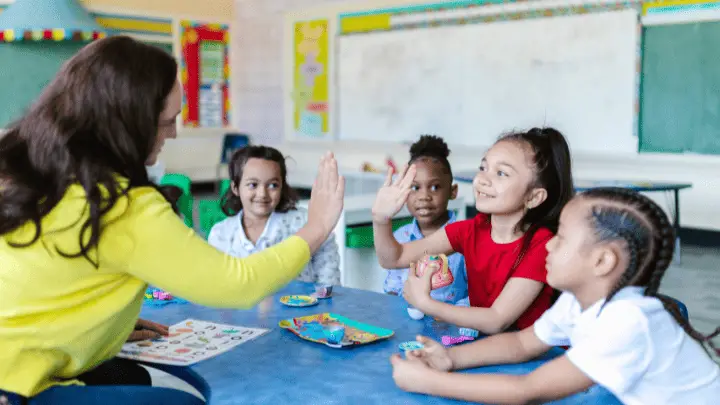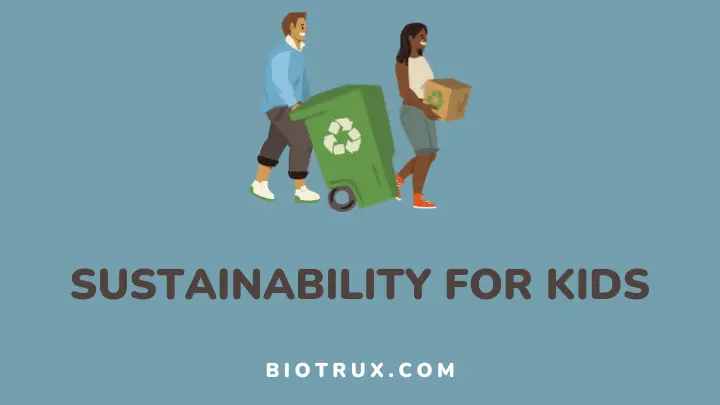Hey there, parents and teachers. Are you looking for ways to inspire the next generation to take care of our planet? Look no further than sustainability for kids. It’s never too early to start teaching kids about the importance of living sustainably.
That’s why I’ve put together a concise guide on sustainability for kids to help you teach your little ones how to live in harmony with nature. From understanding the three R’s (Reduce, Reuse, Recycle) to classroom learning and parental involvement, this guide has got you covered.
So, let’s dive in and empower our children to impact our world positively.
Why Teach Sustainability to Kids?
1. Instilling a sense of responsibility
By teaching kids about sustainability, we encourage them to take responsibility for their actions and environmental impact.
When children learn about reducing waste, conserving resources, and recycling, they understand the importance of their choices and how they can make a positive difference.
2. Fostering critical thinking skills
Sustainability education promotes critical thinking skills by encouraging children to question and analyze the impact of their actions.
Kids learn to think creatively and find innovative solutions to environmental challenges. This helps develop problem-solving skills that can be applied to other areas of their lives.
3. Building a connection with nature
Teaching kids about sustainability helps them develop a deeper connection with nature.
When children understand the value and beauty of the natural world, they are more likely to develop a sense of awe and respect for it.
This connection can lead to a desire to protect and preserve the environment for future generations.
4. Creating lifelong habits
By teaching sustainability early on, we can help children develop lifelong habits prioritizing the planet’s well-being.
When sustainability practices become ingrained in their daily lives, they are likelier to continue these habits into adulthood.
This creates a ripple effect as they become role models for others and contribute to a more sustainable society.
5. Empowering future leaders
The children of today are the leaders of tomorrow. By teaching sustainability, we empower them to become environmentally conscious and responsible leaders who can create positive change.
These future leaders will have the knowledge, skills, and passion to address environmental challenges and make informed decisions that benefit both people and the planet.
Key Concepts of Sustainability for Kids
1. Reduce, Reuse, Recycle: The three R’s explained with practical examples
When teaching kids about sustainability, one of the key concepts to focus on is the three R’s: Reduce, Reuse, and Recycle. By understanding and practicing these principles, kids can positively impact the environment and contribute to a more sustainable future.
- Reduce: This concept is about using fewer resources and creating less waste. Kids can help the environment by turning off lights, using less water when brushing their teeth or taking a shower, and bringing reusable containers.
- Reuse: Reusing items instead of throwing them away helps to conserve resources and reduce waste. Kids can reuse plastic bags, water bottles, and paper by using them multiple times before disposing of them. They can also donate old clothes, toys, and books to those in need instead of throwing them away.
- Recycle: Kids can learn which items can be recycled in their community and help sort recyclables from trash. They can also participate in recycling programs at school or in their neighborhood to ensure that recyclable materials are properly processed.
These simple actions can make a big difference in preserving our planet for future generations.
2. Energy conservation and the importance of renewable energy sources
Energy conservation means using energy wisely and not wasting it. Kids can conserve energy by turning off lights and electronics when not in use, taking shorter showers, and using energy-efficient appliances.
Renewable energy sources, like solar and wind power, are critical because they do not deplete natural resources or produce harmful greenhouse gas emissions.
Kids can learn about renewable energy and its environmental benefits by building solar-powered models or learning about wind turbines.
3. Water conservation and the significance of clean water
Teaching children about water conservation helps them understand the importance of using water wisely and not wasting it. Kids must know that water is a limited resource, and they can contribute to preserving it.
Furthermore, emphasizing the significance of clean water teaches kids the importance of having access to safe and clean drinking water. They can learn about the global water crisis and understand its impact on communities that lack access to clean water.
Teaching Sustainability in the Classroom

Teaching sustainability in the classroom is a valuable way to instill important values and practices in students from a young age. Here are five simple and effective ways to teach sustainability in the classroom:
1. Incorporate hands-on activities: Engage students in interactive projects highlighting the importance of sustainable practices, such as planting and caring for a school garden, recycling campaigns, or creating eco-friendly crafts.
2. Use real-life examples: Integrate real-life examples of sustainability into your lessons, discussing topics like alternative energy sources, water conservation, and reducing waste. Encourage students to share their ideas and experiences related to sustainability.
3. Integrate sustainability across subjects: Teachers should show students how sustainability is connected to different subjects, such as science, math, and social studies. For example, explore the environmental impact of pollution in science class or calculate the carbon footprint of everyday activities in math class.
4. Teach responsible consumption: Discuss the importance of responsible consumption and its environmental impact. Encourage students to make sustainable choices in their everyday lives, such as using reusable water bottles and reducing single-use plastics.
5. Encourage critical thinking: Promote critical thinking skills by encouraging students to question and analyze sustainability issues. Help them understand the connections between their actions and the environment and challenge them to develop innovative solutions to environmental problems.
By incorporating these strategies into the classroom, teachers can empower students to become future leaders and advocates for sustainability.
Empowering Sustainable Choices at Home

Parental involvement in teaching kids about sustainability at home is an important step toward creating a greener and more sustainable future. Here are simple ways parents can instill sustainable choices at home for kids:
1. Encourage recycling: Teach your kids about the importance of recycling by setting up designated recycling bins for different materials like paper, plastic, and glass. Show them how to properly sort and dispose of recyclables, and explain why it is important for protecting the environment.
2. Save energy: Teach your kids to be mindful of energy consumption by turning off lights and electronics when they’re not in use. Encourage them to use natural light during the day and unplug chargers when not charging anything. These small habits can help reduce electricity bills and waste.
3. Practice water conservation: Teach your kids the value of water and the importance of conserving it. Encourage them to turn off the faucet while brushing their teeth, take shorter showers, and avoid leaving taps running unnecessarily.
4. Grow your food: Get your kids involved in gardening and teach them the benefits of growing their food. Gardening teaches children about sustainable agriculture and where their food comes from, whether in a backyard garden or on a balcony.
5. Reduce waste: Teach your kids about the 3 R’s: reduce, reuse, and recycle. Encourage them to use reusable water bottles and lunch containers instead of disposable ones. Teach them to bring reusable bags when shopping and to think twice before buying items with excessive packaging.
By incorporating these simple practices into your daily routine, you can empower your kids to make sustainable choices at home and contribute to a more sustainable future.
Possible Challenges and Obstacles
Teaching kids about sustainability can be a rewarding but challenging task. There are several obstacles that teachers and parents may face in their efforts to educate children about the importance of sustainability.
- One challenge is resistance to change, as some children may resist altering their habits or behaviors.
- Another primary challenge parents and teachers face is limited sustainability awareness or understanding. Teaching sustainability requires a solid grasp of the environmental, social, and economic aspects, which some educators and parents may be unfamiliar with.
- Limited resources in terms of materials and time can also pose challenges.
- Designing sustainability lessons that cater to various age groups can present a challenge. It can be challenging for young children to grasp intricate ideas, whereas older children may require more detailed conversations to maintain their focus and curiosity.
Despite these obstacles, we can overcome them with patience, creativity, and dedication and instill a sense of sustainability in future generations.
FAQs
How can you make sustainability interesting for kids?
Engage children in sustainability by introducing enjoyable activities, interactive games, and hands-on learning experiences demonstrating sustainable practices’ positive effects.
What is the best way to explain sustainability to kids?
When teaching children about sustainability, using easy-to-understand words, relatable situations, and interactive images is important to help them grasp the concepts more effectively.
What are some age-appropriate books on sustainability for kids?
Some age-appropriate books on sustainability for kids include “The EARTH Book,” “Why Should I Recycle,” and “The Last Tree.”
How can kids get involved in sustainability beyond school?
Children can be encouraged to engage in sustainability activities outside of school by participating in community clean-up events, joining eco-clubs, and exploring extracurricular activities focusing on sustainability.
What are some eco-friendly craft ideas for kids?
Some eco-friendly craft ideas for kids include creating bird feeders from recycled materials, making seed bombs, and designing reusable tote bags.
How can you encourage kids to eat sustainably?
Ways to promote sustainable eating habits for kids are to engage them in the meal planning process, expose them to plant-based dishes, and prioritize local and organic food options.
Leading by Example: Role of Teachers and Parents
Teachers and parents play a crucial role in teaching sustainability to children. By leading by example, they can show children the importance of caring for the environment and making sustainable choices.
Teachers can incorporate sustainability into their lesson plans, teaching children about recycling, reducing waste, and conserving energy. Parents can involve children in activities like gardening or composting, teaching them firsthand about the importance of sustainable practices.
By teaching sustainability to kids, teachers and parents are helping protect the planet and shaping future generations who will prioritize environmental responsibility.
You can also learn more about waste management for schools.
Thanks for reading.
